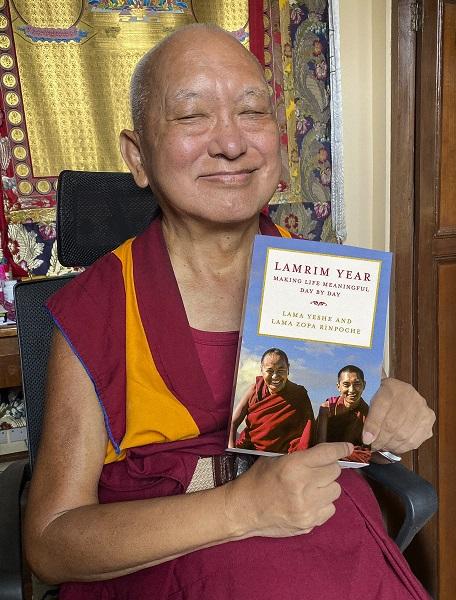Dear Friends,
Thank you so much for your interest in and support of the Lama Yeshe Wisdom Archive. Please feel free to share this eletter on social media or anywhere else. We would love more people to see it!
And thank you for your Saka Dawa donations and for all your support of our forthcoming Lamrim Year web application! As we mentioned before, the very popular LYWA free book, Lamrim Year, published in 2021, is soon to be released as a FREE web application. We receive a lot of positive feedback about the book and we hope that the web app will provide you with even more accessibility and support for your daily lamrim meditations.
Here’s what Ruth Fitzpatrick from Australia shared with us about her experience with Lamrim Year:
I write to express my sincerest and heartfelt gratitude to you and all those involved in compiling and creating the Lamrim Year text. It has been and continues to be for me such a skillful, inspiring and accessible method in my aspirations to understand and realize the path of Dharma, and particularly so in helping to deepen my connection to these wonderful beings—Lama Zopa Rinpoche and Lama Yeshe.
I have based my morning practice for some time on the lamrim section of the Lama Chöpa, but since generously receiving this text I have found it has so richly enlivened my attempts to understand and embody these fundamental teachings and practices. In following the place within the lamrim where my partner is practicing under the instruction of Rinpoche, I have begun in the bodhicitta section, and, where possible, I am reading the corresponding section in Pabongka’s Liberation in the Palm of Your Hand. If commitments allow, I will immerse myself in other sections that need strengthening, such as refuge.
Rather than this perhaps unnecessary detail, overall, I just wanted to communicate my gratitude for the skillful effort to all those who have helped produce this offering so they have some awareness of the benefits of their labor that so beautifully and effectively helps transmit the Dharma and the precious blessings of these precious teachers.
Finally, with no intention to be contriving/creating further promotional material, I wanted to reiterate to your team any encouragement should they ever need it. I still find, day after day, the wisdom in this beautiful text, Lamrim Year, is so effective for transforming afflicted self-grasping states into wisdom, peace and (I hope) wholesome states for others. Perhaps it was something to do with auspicious timing, but it has certainly enabled me to enter more deeply into lamrim topics generally, as they appear in other contexts/practices/contemplations.
So profoundly grateful for this.
We expect to launch the Lamrim Year web app in the next few weeks. Stay tuned for news of the launch!
From the Video Archive: The Peerless State of Perfect Peace
This month from the LYWA video archive, Lama Zopa Rinpoche explains how the most important thing we can do is remember to live for others, day and night, all the time. Rinpoche says when we are responsible for causing the happiness of others, our minds are filled with joy and satisfaction. Our short life has purpose. But even more importantly, Rinpoche notes that for lifetimes to come we create the cause of the peerless state of perfect peace for ourselves and for those we serve. These teachings were hosted by the Kurukulla Center at the Wisdom Publications offices in Boston, Massachusetts in September, 1990.
Visit and subscribe to the LYWA YouTube channel to view more videos freely available from our archive. See also the FPMT YouTube channel for many more videos of Lama Zopa Rinpoche’s teachings.
On the LYWA Podcast: The Dharma Will Protect Us
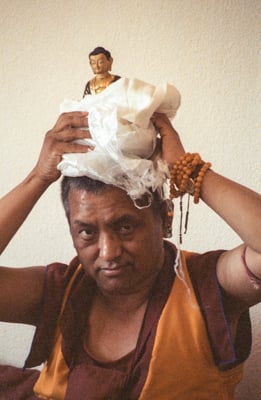 How to live the life? First your attitude becomes Dharma. Then with that attitude one lives the life, one does the works, one does the activities.
How to live the life? First your attitude becomes Dharma. Then with that attitude one lives the life, one does the works, one does the activities.
– Lama Zopa Rinpoche
This month on the LYWA podcast, Lama Zopa Rinpoche observes that we think we can rely on purification practices to deal with our negative karma. Rinpoche warns us against relying too much on purification because it must be done perfectly to be effective. Rinpoche then directs our attention to the suffering realms around us and explains that in order to resist our karmic tendency to accumulate such causes of suffering, our main effort should be focused on living our lives according to the Dharma. These teachings were given by Rinpoche in Sydney, Australia in 1993. Follow along with the transcript on our website.
The LYWA podcast contains hundreds of hours of audio, each with links to the accompanying lightly edited transcripts. See the LYWA podcast page to search or browse the entire collection by topic or date, and for easy instructions on how to subscribe.
WHAT'S NEW ON OUR WEBSITE
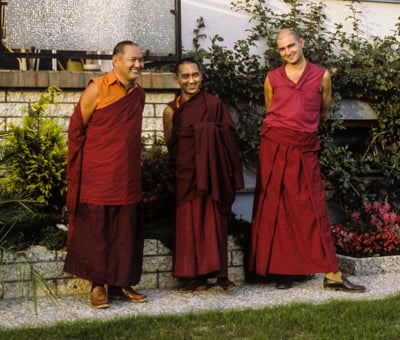 This month we have posted A Tribute to Lama Yeshe, an edited transcript of interviews with Lama Zopa Rinpoche shortly after Lama Yeshe passed away. Rinpoche describes how he first met Lama Yeshe and speaks of his last illness and of his pure compassion and great spiritual attainments. The interviews—ten hours of conversations with Piero Cerri—were at Tushita-Delhi and Tushita-Dharamsala in April 1984.
This month we have posted A Tribute to Lama Yeshe, an edited transcript of interviews with Lama Zopa Rinpoche shortly after Lama Yeshe passed away. Rinpoche describes how he first met Lama Yeshe and speaks of his last illness and of his pure compassion and great spiritual attainments. The interviews—ten hours of conversations with Piero Cerri—were at Tushita-Delhi and Tushita-Dharamsala in April 1984.
We have also posted a Rinjung Gyatsa PDF, which presents a list of the oral transmissions given by Lama Zopa Rinpoche in Bodhgaya in 1982 and at Kopan Monastery in 1985. As transmitted by lineage lamas, Rinjung Gyatsa is a collection of 305 tantric deities from the four classes of tantra and the various Buddhist traditions, together with the methods of initiating disciples into their practice. As part of the Rinjung Gyatsa series of initiations at EEC1, Lama Zopa Rinpoche gave an oral transmission of the Twenty-One Taras according to the Suryagupta tradition. The Twenty-One Taras text provides the image for each of the deities in the Suryagupta tradition, combined with Praises to the Twenty-One Taras. Compiled and edited by Hermes Brandt, June 2022. Visit our First Enlightened Experience Celebration (EEC1) webpage to access the collection of resources from EEC1, an amazing Dharma event held in India from January to June 1982.
We’d like to remind you that in May 2022 Khadro-la observed that there are obstacles to Lama Zopa Rinpoche’s health and students were asked to recite the refuge and bodhicitta prayer for two months and dedicate for Rinpoche’s long life. In How to Meditate on the Refuge and Bodhicitta Prayer, Rinpoche explains how to make this prayer meaningful and heartfelt. Edited by Ven. Sarah Thresher. Read on to find it featured in this month's teaching below.
We also have new additions to Lama Zopa Rinpoche's Online Advice Book this month to share with you:
- Every Sentient Being Is Most Precious: Rinpoche explains why we need to develop great compassion in this long letter to a student who was helping at a Dharma center. The letter includes several inspiring quotations.
- Transforming Obstacles into the Path to Enlightenment: This advice was given to a nun who had become very sick and thought she had COVID-19. Rinpoche explains how to utilize unfavorable conditions on the path to enlightenment by doing tonglen practice.
- Positive Behavior Strategies: A student was having difficulties with her son and asked Rinpoche how she could help him. In this extensive advice, Rinpoche offers suggestions on how the child can create the cause of happiness and peace by cherishing others and avoiding negative actions of body, speech and mind.
- Long Chenrezig Mantra: Rinpoche sent this message via audio after going to the dentist. Rinpoche advises the benefits of reciting the long Chenrezig mantra before the appointment.
You can always find a list of all the newly posted advices from Lama Zopa Rinpoche on our website.
LYWA Community News
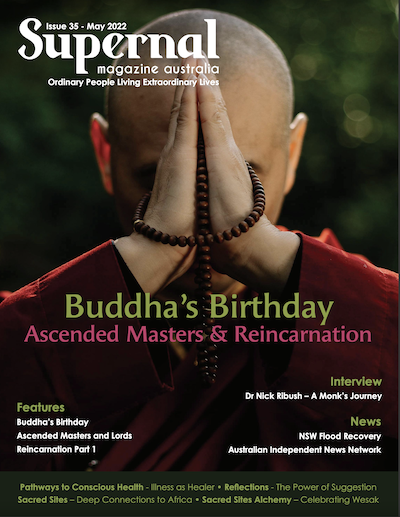 I was recently interviewed by Supernal Magazine, a free Australian online spiritual magazine, for their special Saka Dawa edition. You can find the interview here if you’re interested. Thank you!
I was recently interviewed by Supernal Magazine, a free Australian online spiritual magazine, for their special Saka Dawa edition. You can find the interview here if you’re interested. Thank you!
You may also want to check out two podcasts produced by FPMT International Office: Lama Zopa Rinpoche Essential Extracts Podcast, which shares Rinpoche’s indispensable wisdom in a concise audio format, and Lama Zopa Rinpoche Full-length Teachings Podcast, which features the unedited audio from recent teachings by Lama Zopa Rinpoche.
As always, we appreciate your interest and support of LYWA. Please let us know if there's anything that we can do for you.
Big love,

Nick Ribush
Director
THIS MONTH'S TEACHING: How to Meditate on the Refuge and Bodhicitta Prayer
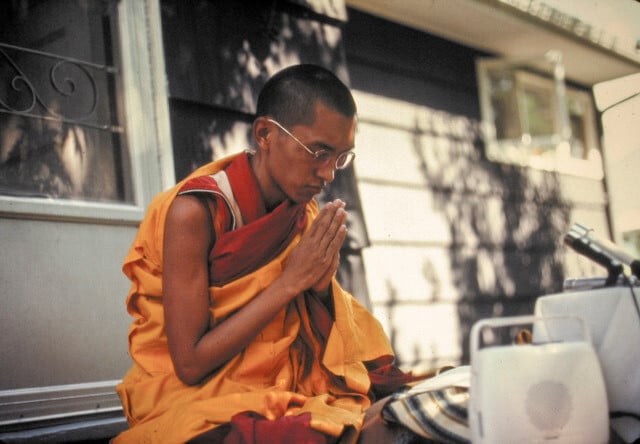 I go for refuge to Buddha, Dharma and Sangha
I go for refuge to Buddha, Dharma and Sangha
Until enlightenment is achieved.
Due to the merits from giving and the other perfections,
May I achieve enlightenment in order to benefit the transmigrating beings.
Here is the meditation to be done with this prayer for taking refuge and generating bodhicitta.
TAKING REFUGE
First generate renunciation to your own suffering
Think,
I myself have been experiencing the oceans of samsaric suffering from beginningless rebirth.
Bring to mind the [particular sufferings of the six realms]: the eight major sufferings of the hot hells, the eight major sufferings of the cold hells, the sufferings of the four neighboring hells and those of the ordinary hells that you have experienced numberless times.
Then think of the sufferings of the hungry ghosts: the general sufferings of heat and cold, hunger and thirst, and fear and exhaustion. And the particular sufferings of hungry ghosts with outer obscurations, inner obscurations, and knots.
Think of the sufferings of the animals: being eaten by one another, being stupid and ignorant, experiencing heat and cold, hunger and thirst, and being exploited and used for work.
Think how humans suffer from birth, aging, sickness, death, being separated from the pleasant, meeting with the unpleasant, constantly seeking desirable objects but never receiving any satisfaction from them and the suffering of having deluded aggregates.
And think how the suras experience the suffering of envy and fighting with the asuras and how the asuras experience unimaginable mental sufferings when they see the five signs of death.
Then contemplate the general sufferings of samsara: The six types—nothing is definite, nothing brings satisfaction, having to die and leave the body again and again, having to take rebirth again and again, constantly moving from high to low and being alone and without a helper. And the three types—the suffering of pain, the suffering of change and pervasive compounding suffering. [In short],
Wherever I go is a place of suffering.
Whomever I accompany is a friend of suffering.
Whatever I enjoy is an enjoyment of suffering.
And think that,
How I circle in samsara is through the twelve dependent related limbs—ignorance, compounding action, consciousness, name and form, the six sense bases, contact, feeling, craving, grasping, becoming, birth, old age and death.
[In this way] try to get some feeling of how you yourself have been suffering since beginningless time.
Then think,
If I don’t discover the four noble truths—true suffering, the true cause of suffering, the true cessation of suffering and the true path—I will have to experience the general sufferings of samsara and the particular sufferings of the lower realms forever. Endlessly.
This is incredible.
Next generate compassion for the suffering of others
Now think,
In the same way, numberless hell beings have been experiencing the oceans of samsaric suffering—the general sufferings of samsara and particularly the sufferings of the lower realms—since beginningless time. Wow, wow, wow, wow! Numberless hell beings! I can’t stand it for a minute that even one hell being has to experience all this. I can’t stand not being able to liberate that hell being from the oceans of samsaric sufferings and bring it to enlightenment. But there are numberless hell beings suffering like this. I can’t stand it for even a second that they are suffering so much and that they will have to suffer like this endlessly.
Then think of all the hungry ghosts,
Numberless hungry ghosts have been experiencing the general sufferings of samsara and the particular sufferings of the lower realms since beginningless time. I can’t stand for a second that even just one hungry ghost has to experience this, but there are numberless hungry ghosts and they will have to experience all these sufferings endlessly until they are liberated.
Now think of the animals. Can you imagine even one animal experiencing all this suffering? How can you stand even a second not being able to liberate that animal and bring it to enlightenment? But there are numberless animals who have been experiencing the general sufferings of samsara and the particular sufferings of the lower realms since beginningless time and if they are not liberated they will have to experience these sufferings endlessly. Wow, wow, wow.
Now think of the human beings. Can you imagine even one human being experiencing all this suffering? Wow, wow, wow, wow. Now there are numberless human beings who have been experiencing the general sufferings of samsara and the particular sufferings of the lower realms endlessly and if they are not liberated they will have to continue experiencing these sufferings endlessly. Wow, wow, wow. You can’t stand it.
Now, numberless suras and numberless asuras—wow, wow, wow—have been experiencing the general sufferings of samsara and particularly the lower realms’ suffering since beginningless rebirth and if they are not liberated they will have to experience all these general and particular sufferings endlessly.
The three causes of Mahayana refuge
Therefore think,
I must liberate all these numberless sentient beings from the oceans of samsaric suffering and its causes, karma and delusion. Therefore, I wholeheartedly go for refuge to Buddha, Dharma and Sangha.
Completely rely upon Buddha, Dharma and Sangha to help you do this. You can see how incredibly serious it is to take refuge in Buddha, Dharma and Sangha. This thought relying on Buddha, Dharma, Sangha is refuge. It is Mahayana refuge because you have fear of your own samsaric suffering, and compassion for sentient beings who are also experiencing oceans of samsaric suffering. Then you are relying on Buddha, Dharma and Sangha who have the complete power and all the qualities to help. Since your mind is qualified with these three things it is Mahayana refuge. Fear of your own suffering and relying on Buddha, Dharma and Sangha is the Lesser Vehicle refuge. With the addition of the third cause, compassion, it becomes Mahayana refuge. The thought relying upon Buddha, Dharma and Sangha with the mind perfected with these three causes is Mahayana refuge.
Causal refuge and resultant refuge
The first [line of the prayer] shows causal refuge,
I go for refuge to Buddha, Dharma and Sangha.
This is taking refuge in Buddha, Dharma and Sangha possessed by others’ minds.
For Buddha, there is the absolute buddha and buddha for the all-obscured mind. The absolute buddha is a buddha’s holy mind, the dharmakaya, and the ultimate nature of that [svabhavikaya]. The buddha for the all-obscured mind is a buddha’s holy body, the rupakaya. Then the Dharma has the absolute Dharma—the wisdom directly perceiving emptiness—and the Dharma for the all-obscured mind—the Tripitaka or texts. Then the Sangha has the absolute Sangha and the Sangha for the all-obscured mind. The absolute Sangha is any person, ordained or lay, who has directly realized emptiness. The Sangha for the all-obscured mind is four fully ordained people who don’t have that realization but who are living in full ordination. Taking refuge in both of these is causal refuge.
The second line,
Until enlightenment is achieved.
Contains the resultant refuge. You rely on Buddha, Dharma and Sangha for what? For you to actualize the Dharma, the wisdom directly perceiving emptiness. Through that, you become the absolute Sangha and through that you achieve the dharmakaya and the buddha for the all-obscured mind. This is the resultant refuge.
GENERATING BODHICITTA
[When you are generating bodhicitta, put together all the merits of yourself and all the buddhas, bodhisattvas and sentient beings and say,]
Due to all the past, present and future merits collected by me, by the sentient beings and by all the buddhas,
May I achieve full enlightenment in order to benefit the transmigrating beings.
The meaning of "in order to benefit”
Here, when you say “in order to benefit” it has two meanings. The first meaning is,
In order to liberate the numberless transmigrating beings, the numberless hell beings, hungry ghosts, animals, humans, suras, asuras and intermediate state beings. In order to free them from the oceans of samsaric suffering—the sufferings of the upper realms and the lower realms—and the causes of suffering, karma and delusions.
Therefore think,
I can’t wait even a minute or a second to liberate the transmigrating beings who have been experiencing the oceans of suffering of the hell realms, hungry ghosts, animals, human beings, suras, asuras and intermediate state from beginningless rebirth.
Then, the second meaning of “in order to benefit” is,
In order to bring them to full enlightenment.
Therefore think that you will bring the numberless hell beings, hungry ghosts, animals, humans, suras, asuras and intermediate state beings to enlightenment without even a second’s delay.
The meaning of “transmigrating being”
The Tibetan word for “transmigrating being” is dro, and dro la pan chir means “in order to benefit the transmigrating beings.” One meaning of “transmigrating being” is that from the time they are born sentient beings are continuously going toward death without even a second’s pause. The other meaning is that sentient beings are continuously migrating under the control of karma and delusion, taking birth in the six realms and experiencing the oceans of suffering over and over again.
Meditating on emptiness while generating bodhictta
While you are generating bodhicitta,
May I achieve full enlightenment in order to benefit the transmigrating beings.
Meditate on emptiness by thinking,
May the I, who is merely labeled
Achieve enlightenment, which is merely labeled
In order to benefit the transmigrating beings who are merely labeled.
If you think of emptiness (tong pa nyi) while you are generating bodhicitta, then you will have generated renunciation, bodhicitta and emptiness—all the three principal aspects of the path—while doing the prayer for taking refuge and generating bodhicitta. The Buddha gave more than a hundred volumes of teachings (Kangyur) and the pandits gave more than two hundred volumes of teachings (Tengyur). The three baskets of teachings of the Lesser Vehicle, Mahayana Paramitayana and Mahayana Secret Mantra are all included in the lamrim, in the paths of the lower, middle and higher capable beings and all three of these paths are embodied in the teachings of the three principal aspects of the path. Therefore, by integrating these three principal aspects into the refuge and bodhicitta prayer you will be practicing the very heart of the whole entire Buddhist path.
Put your hands together when generating bodhicitta
Generally when reciting this prayer, people can put their hands together at the heart in the form of prostration, cupped as though holding a wish-granting jewel. However in my case, for example, when I was in hospital I couldn’t use both hands. I could put my left hand up and since I couldn’t bend the fingers of my right hand I just rested it against the left hand. I felt at a disadvantage because I couldn’t do a full prostration like before. Putting the palms together at the heart means prostrating to Buddha, Dharma and Sangha and meditating on generating bodhicitta.
The merit of generating bodhicitta
Each time we generate bodhicitta by putting our palms together at the heart, the merit we collect is amazing and unbelievable. Lama Atisha in the Light of the Path quotes the Sutra Requested by Viradatta,
Even if you were to offer to the Buddha for eons
Buddha fields equaling the sand grains of the Ganga
Filled with jewels,Putting your palms together
And generating the thought of bodhicitta,
Collects far greater merit.
It means that the merit of offering an unimaginable number of buddha fields filled with the seven types of jewels to the Buddha is unbelievable and unimaginable, but putting the palms together and simply generating the bodhicitta thought, “May I achieve enlightenment in order to benefit the transmigrating beings” collects far greater merit.
Meditating on emptiness at the end of the prayer
If you are unable to meditate on emptiness while generating bodhicitta, then when you finish the prayer you can think,
This real I who is seeking enlightenment is empty.
This real action of seeking enlightenment is empty.
This enlightenment that I am seeking is empty.
The sentient beings for whom I am seeking enlightenment are empty.
This is based on the advice of the highly learned and accomplished lama Je Drubkhangpa.
Excerpted from advice given by Lama Zopa Rinpoche for a student with a rare neurological disease. Dictated to Ven. Sarah Thresher at Tushita Meditation Centre, Dharamsala, India, on May 6, 2012. Edited by Ven. Sarah Thresher. You can find out more about this advice by visiting our website here.























